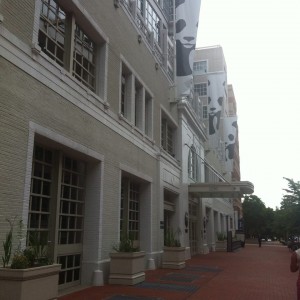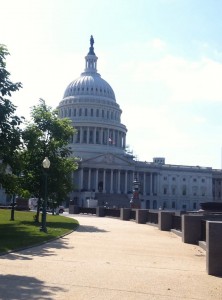After finishing the first year of my master’s degree in Climate Science and Policy (CSP) at Bard College’s Center for Environmental Policy (Bard CEP) in Annandale on Hudson, NY, I changed from the landscape of the Hudson Valley to the wonderful city of Washington, D.C. and couldn’t be happier. As much as I enjoy being surrounded by nature and the peacefulness around it, the bottom line is that I’m a city girl, and this was exactly the spark needed in the right moment. So what brought me to D.C? An exciting internship opportunity with one of the world’s oldest and biggest environmental non-governmental organization, the World Wildlife Fund (WWF).

The Panda story
WWF was established in Switzerland in1961 by a group of European scientists, naturalists, businessmen and political leader in the scope of the Morges Manifesto. Fundamentally, the Morges Manifesto recognized that there was a lack of financial support to protect the Earth’s wildlife and their environment while the expertise existed. Therefore, WWF is created as an independent international fundraising organization to bring substantial financial support to species conservation. Chi-Chi, a giant panda at the London Zoo at the time that WWF was being created, served as their inspiration for the logo. According to one of WWF’s founders, Sir Peter Scott, they wanted a beautiful, loved and endangered animal, but also an animal that had an impact in black and white to save on printing costs.
Over the years, the WWF network has grown to 30 national organizations with 90 offices globally. It works in 100 countries with over 5,900 staff worldwide and over 5 million dedicated supporters. Each national organization has their own governing Boards and staff that implement projects autonomously, and contribute with technical expertise and funding to WWF’s global conservation program. WWF’s mission is “to conserve nature and reduce the most pressing threats to the diversity of life on Earth” and its vision is “to build a future in which people live in harmony with nature” by “conserving the world’s biological diversity, ensuring that the use of renewable natural resources is sustainable and promoting the reduction of pollution and wasteful consumption”.
The Panda in the US and climate change
As mentioned above, WWF-US Headquarters is located in Washington, DC. A city full of young professionals with cultural and ethnic diversity, home for many others environmental organization, and the heart of US legislation and decision makers.

Besides its active work for over 50 years in species conservation, fighting climate change is also part of WWF’s current work. It recognizes the urgency to address climate change and works towards a climate-resilient and zero-carbon planet, powered by renewable energy. WWF-US combines global expertise to help communities adapt to climate change while engaging the private sector to reduce carbon emissions, eliminate deforestation and advance climate change policies.According to polls conducted by The Natural Resources Defense Council (NRDC) and the reactions to the latest EPA power plant regulation, the US Latino population is the most affected by the impacts of climate change and they show a high demand and support for domestic climate action.
I joined the WWF-US Climate family this summer working as the Latino Climate Change Communications and Policy Intern. The position is heavily focused on supporting an important initiative that aim for raising awareness and mobilizing the US Latino population on climate action. It also involves the connection to what is happening in the Latin America and Caribbean (LAC) region and the measures they are taking. Additionally, it is highly linked to the United Nations Framework Convention on Climate Change (UNFCCC) process and the work towards the new global climate agreement post-2020. I spend my days researching about the current status of climate policies in the LAC region, contributing to the WWF Network’s strategic thinking on public engagement in LAC and WWF’s UNFCCC advocacy strategy, and coordinating the communication for WWF’s LAC Regional Climate Change Strategy that includes more than 10 offices.
Making a difference in history
Every organization around the world that is involved in climate change like WWF, is working closely with governments to provide technical expertise that will allow an ambitious and doable new climate agreement. The spotlight right now is in Lima, Peru where the next Conference of the Parties (COP) will be held in December this year. As the COP President, the Peruvian government has the responsibility to lead the negotiation process for the new climate agreement that must be adopted in 2015 and enter into force in 2020. Beyond the formal responsibility the Peru has as COP President, the LAC region has an opportunity before it come together a demonstrate in a variety of ways that it cares about climate change and is ready to take action. WWF is working intensely on this process as a global network, and I’m more than thrilled to be part of it. I’ll stay with the Panda family until December, and I’m excited to see what happens along the journey.

